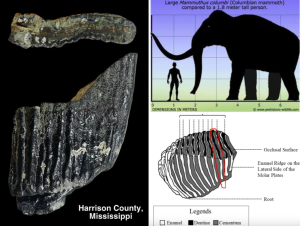Scientists with the Mississippi Department of Environmental Quality (MDEQ) have confirmed that fossil fragments from a Colombian mammoth were found along the state’s Gulf Coast, marking the first discovery of its kind in the region.
Cole Moody, an area resident, located and recovered two different parts of a mammoth’s tooth in the low-tide waters of Harrison County two weekends ago. This discovery, per state officials, will allow researchers to get a better look at the creatures that roamed Mississippi prior to human documentation.

“This fossil gives State Survey geologists a much better understanding of the ice-age landscape now lost beneath the sea,” a statement from MDEQ reads. “The discovery of mammoth remains paints a picture of ice-age grassy coastal meadows bordered by woodland corridors occupied by streams.”

Before the mammoth’s fossilized remains were found, geologists believed large mammals such as herds of horses, giant bison, saber-toothed cats, American lion, giant ground sloths, tapirs, and elephant relatives such as mastodons almost exclusively occupied this lost world. Also, Paleoindian, the ice age hunters said to be the first people to call Mississippi home, would have found a bounty of game on this land now buried beneath the Gulf waters.
Evidence from these lost ice age coastal lands comes largely from fossils and artifacts better preserved and discovered in other places along the Gulf, particularly in Florida and Texas. Based on recorded information, Mississippi was believed to be like its peers until Moody discovered the fragments.
“This exciting find is extremely significant, to say the least,” MDEQ added. “Because mammoths are grazers, they inhabit specifically grassland environments. This is unlike their cousins, the mastodon, who are browsers and can inhabit a wide variety of environments.”
As the last interglacial ended and the next glacial cycle began, sea levels fell drastically. At the height of the Last Glacial Maximum, an estimated 20,000 years ago, sea levels were some 400 feet lower than they are today. Mississippi then had significantly more land mass due to part of the shelf being exposed. The environment would have consisted of broad coastal meadows dissected by coastal streams in a climate somewhat cooler than that of today.
This last glacial cycle ended some 11,700 years ago as the last of the continental glaciers melted and sea levels began to rise to the coastline that we see today, only some 5 to 8,000 years ago, according to data from MDEQ. The fossil remains of the Columbian mammoth were buried in the Pleistocene meadow soil, now drowned by the Mississippi Sound.
The mammoth fossils were then likely re-exhumed from the seabed by strong storms and ocean currents. The fossils were quickly colonized by sea life on the modern sea bed, as the mammoth tooth fossils are now encrusted with the remains of bryozoans, barnacles, corals, and oysters.
The Colombian mammoth fossils have since been reposited in the Mississippi Museum of Natural Science’s paleontological collections for further study.



